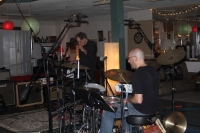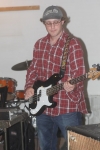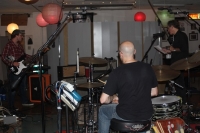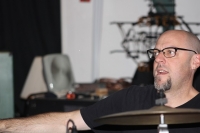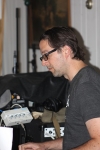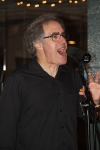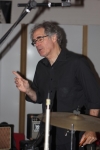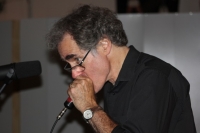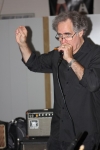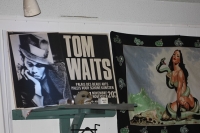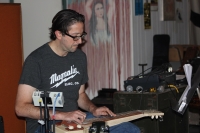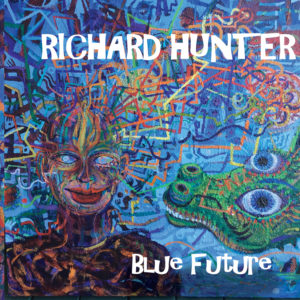
How I recorded “Put The Lever Down” (2017 version)
Where “Put the Lever Down” came from
I wrote the lick and harmony on which “Put the Lever Down” is based while I was hanging out in my car at one of my daughter’s skating meets around 1981, playing with a Dorian Minor tuned diatonic harp; I don’t remember whether I recorded the licks on the spot, or if I memorized the piece. I was already in the habit of carrying a portable Radio Shack cassette recorder around with me at the time. However I did it, I had the song’s structure laid out when I went to the studio not long after to record my first single.
“Lever Down” was the one of the first two pieces I recorded with Erik Lindgren producing, in 1982. We recorded to 8 tracks of analog tape, the state of the art in small-studio setups at the time, and the whole thing took 5 hours from first take to final mix; everyone was just on fire that day. Andrew Maness played guitar through a pitch shifter–I think it was a Boss Octaver–and I played harmonica through a Shure 545 (I think, one of the old pistol grip models that unbeknownst to me at the time was one of Paul Butterfield’s favorites) into a Boss BF-2 Flanger and a Fender Champ amplifier, one of the old ones that had a single knob for volume, in that order.
The amp was Erik Lindgren’s; he found it in the garbage in Cambridge, MA one day when he was out on a stroll, took it home and plugged it in, and found that it was working. My guess is that some very angry girlfriend or wife dumped that thing in the garbage, because there is no damn way that anybody who’s ever plugged an instrument into a vintage Champ is going to wittingly dump it on the street.
It was one of my first recordings using an altered tuning, in this case a Dorian Minor tuning (D Dorian minor in 2nd position), played in third position (A Natural Minor in 3rd position) on what would be a standard G harp if we hadn’t retuned it. It was also my most-admired recording for a long time–among other things, it was the theme song for a show on harmonica music titled “The Tin Sandwich” broadcasting on NPR from Worcestor, MA, and it was received with wild enthusiam by reviewers in Boston.
That was then, this is now
I thought of this version of the recording from the start as an update with a wider palette of harmonica orchestration. This version also features the contributions of an excellent band, while the 1982 version only included two human players plus a drum machine. (For all that, it rocked hard, with a raw, furious, mindbending harmonica solo over an implacably relentless, steady groove in the bass via Andrew Maness’s pitch-shifted guitar.) Finally, the idea of a dual lead in the last half occurred to me when I was comparing takes in my home studio and discovered that different takes were mutually complementary–I tended to alternate my phrasing on every take, so when one part was highly active, the other was just hanging fire on one big, screaming note. So this piece includes two big harps chasing each other to the end instead of just one.
In the end, the mix presents a somewhat less orchestrated and more improvised sound than I originally had in mind, and that decision was about making room for the leads–both of which are red-hot by the time the second half is well underway–which might otherwise be smothered in a cloud of harmonicas.
Let’s talk about all those harmonicas. In the meantime, take a listen to the piece. You can hear it at cdbaby. If you use the player below, “Put the Lever Down” is the fifth song on the record, right after my cover of Morphine’s “Early to Bed.”
The Chord Changes Dictate the Harps
The structure of the tune begins with a fierce rhythm lick, articulated by an amped harmonica in alternating octaves via alternate side of the mouth tongue-blocking, followed by a long solo harmonica solo that never dips below the 5th above the root (A, or draw 4) in the second octave. It begins relatively quietly, and ends shrieking and jumping around in the top octave of the harmonica. The harmony shifts from A minor to B minor before settling on A minor under the solo as it digs in, and for this part of the piece I used a standard G harp, a Seydel 1847, playing in third position (A minor on a G harp) and 5th position (B minor on a G harp) as necessary. I also introduce an A Natural Minor harp here playing chords with big, wet, squawking autowah sounds on the 2nd beat of every measure.
When the harmony settles on A minor, I keep that part going and introduce another harmonica entirely, a Chromonica II. This wicked chordal instrument offers lots of cool variations on scale-tone and passing chords in the keys of C, G, A minor, and D minor, and you can hear it in the background here with chorded rock licks that jump back and forth from A minor to D minor.
After the first extended solo, we enter a bridge. The chords on the bridge are a repeating cadence of D minor, G, and A minor, with a crescendo on E7 at the end, and I play the first three chords on a single Dorian Minor-tuned harmonica in the key of D (equivalent to standard G richter), doubled by the Chordomonica II. The D Dorian Minor tuning is made from a G harp by reducing the pitch of the draw 3 and 7 reeds, the 3rds of the scale in 2nd position, by 1/2 step each. (Pitch reduction can be accomplished by filing the reeds, or by matching the right draw reed plate, e.g. a D minor, with the right blow reed plate, e.g. a G.) This yields a harp that offers a minor I chord in second position, a major IV chord, and a minor V–in this case, D minor, G, and A minor. In third position (A minor on a D Dorian harp) the mode is Natural Minor (flatted 3/6/7), which is perfectly usable for lots of cool stuff. The D Dorian harp I used was a Lee Oskar, and I probably put it together by combining reed plates from a D natural minor (draw) and standard G (blow) harps. I used a Seydel Session Steel A harp in 2nd position to play the E7 chords. On all the bridge harp parts, I recorded multiple layers with different FX; see below for a detailed discussion.
After the bridge, the piece includes an extended two-harp solo over alternating A minor and B minor chords. Here I used a standard Seydel 1847 G harp for both of the leads, using 3rd position for the A minor sections and 5th position for the B minor sections. I also used A Natural Minor and B natural minor harps to provide the same chord hits that I performed with the Chromonica II in the first half, and to play rapidly ascending and descending cascades of chord tones, like a big fireworks plume (albeit a plume that’s low in the mix).
There are plenty of harp tracks on every tune on this record, but there aren’t a lot of tunes where I used 6 different harmonicas, with different tunings, or layouts, or performance features like double slides. (That’s 1 G harp, 1 D Dorian (modified G) harp, 1 A Natural Minor, 1 B Natural Minor, 1 standard A, and 1 Chordomonica II.)
Lotta harps, golly, huh? How do we keep alla those harps from stepping on each other? Well, we use a lotta different sounds from our magic RP500 setup, like this…
The FX on “Put The Lever Down”
The first lead on “Put the Lever Down”–the one you hear in the first half of the piece–was recorded live in studio with the band. I used my workhorse ChampB (Champ amp plus Bassman cab) patch for that lead–I wasn’t sure about using something more effected-up, like with a flanger or chorus, for example, notwithstanding that I recorded the 1982 version with a flanger inline–and I decided pretty much on the spot to go with the traditional blues harp sound. I’m glad I did–I was able to use vibrato and other techniques to get a more intensely emotional sound than I think I could have achieved with a flanger.
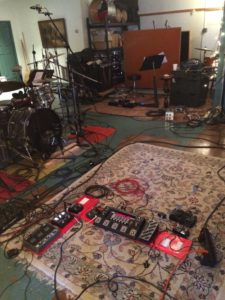
On the bridge, I recorded three big chorded parts, two with the same Lee Oskar D Dorian harp–one with the ChampB patch, one with the autowah patch–and a track using the Chordomonica II into a Digitech iStomp running the Swingshift pitch shifter with a sub-octave added to the tone, into a chorus patch on the RP500 for a big, wide lower-midrange sound. Together these tones produce a big, shifting, deep sound that’s intriguing because it keeps changing in multiple ways.
I recorded the second half live with the band in the studio with the same ChampB setup, but in the end I didn’t much like it. I felt at the time like I was blowing too hard for too long, and the solo seemed to hit a peak early and stay there, which is not tops. By the time I figured that out, in my home studio I had recorded the Chordomonica II parts and the Natural Minor harps, all using various clean reverbed/delayed/chorused sounds, among them a patch that pairs a Tweed Deluxe amp model–nice amp model with a full body that’s not openly distorted–with a TC Electronics chorus model.
All of those parts were intended to provide color and increased intensity as the piece progressed. Maybe they’re mixed a little low for that. The payoff for that decision is that the two lead harps have the freedom to take up a lot of space with lots of movement and color changes in the second half of the piece.
When I decided I didn’t like the second half lead from the studio, I recorded a new one with the ChampB patch. Then I recorded another one with a patch based on a high-gain heavy metal amplifier, which puts a lot of edge on the sound, and a mild chorus effect, which makes a sound that stands out just enough from the traditional ChampB Chicago amped harp sound. I listened to them one at a time, and then listened to them together, at which point I realized that they were mutually complementary. That’s what I sent to Chris Peet for mixing.
I think Chris might already have started mixing the record, maybe even mixing this song, when I sent him the updated solos. Hope not… but all’s well that ends well, though travails did not end there.
A Little More Drama Than Usual
We ended up doing five different mixes on “Put the Lever Down.” In the end I approved the 5th mix for mastering. I listened to the master again just before I sent it off for pressing, and I was aghast to realize that I had approved the wrong mix for mastering! The 4th mix was a lot more dynamic and exciting in the second half than the 5th.
I immediately emailed Ed Abbiati to advise that we needed a new master with the 4th take of “Put the Lever Down.” Ed listened and agree that the 4th take was better. He contacted Alex McCollough at True East Mastering, Alex redid the master for the song with the 4th take that very day, and all was well. Phew.
Performing “Put the Lever Down”
I think that “Put the Lever Down” can be performed effectively by one player–the lead part is the most important one once the rhythm lick that starts the piece has done its work, which is to say by the time the extended solo on A minor begins. If additional players are available, any of the chorded parts played on any suitable chord harmonica instrument would be great, and if two soloists are available, one can do the octave-jumping parts up front, and both can solo together at the end.
Don’t forget that there’s a lot of harmonica technique involved in playing the octave jumps that are the motor behind the rhythm in “Put the Lever Down.” In other words, it’s not just about the FX in this piece. Learn what you can about “corner-switching” techniques. The intensity of the octave jumps in this piece, and the fact that they’re happening on both blow and draw octaves, means that you need a harp that responds reliably at a given pressure level on every note. Lee Oskars are good for that, and I’ve been using Lee Oskars to play this piece for a very long time, especially the bridge.
The key is to make sure that there’s enough difference between the harmonica tones for a listener to tell them apart. To get exactly the same range of tones that I get on this piece, you’ll need a Digitech RP500 loaded with my patch set. But you could get similar kinds of contrasts with a decent amped setup and a pedal effect or two (autowah and chorus preferred, delay pretty high priority too).
The energy in this piece ultimately comes from the wildly driving lick that begins it and the groove that results. The band of Mike Brenner on lap steel, John Cunningham on bass, and Mark Schreiber on drums plays the hell out of it. The harps shout hysterically above the general funky din. What’s not to like? Play this one with your own band.
If you liked that, you’ll like these:
the 21st century blues harmonica manifesto in sound
Get it on Amazon
Get it on iTunes
the rock harmonica masterpiece
Get it on Amazon
Get it on iTunes
Tags In
Related Posts
Leave a Reply
You must be logged in to post a comment.
WHAT’S NEW
Categories
- Audio/Video
- Blog
- Blue Future
- Digitech RP Tricks and Tips
- Discography, CDs, Projects, Info, Notes
- Featured Video
- For the Beginner
- Gallery
- Hunter's Effects
- Hunter's Music
- Huntersounds for Fender Mustang
- Meet the Pros
- More Video
- MPH: Maw/Preston/Hunter
- My Three Big Contributions
- Player's Resources
- Pro Tips & Techniques
- Recommended Artists & Recordings
- Recommended Gear
- Recorded Performances
- Reviews, Interviews, Testimonials
- The Lucky One
- Uncategorized
- Upcoming Performances
- Zoom G3 Tips and Tricks
